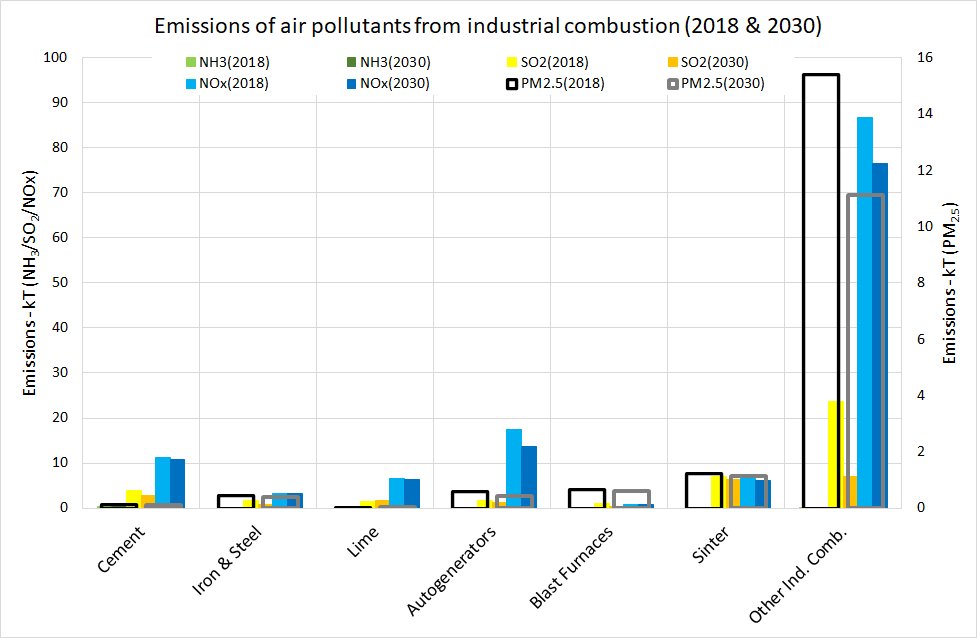Modelling of the energy sector
So far work on the energy sector has concentrated mainly on SO2, NOx, NH3 and fine particulate emissions resulting from power generation, industry and domestic energy sources, combined with corresponding emissions of these pollutants from the transport sector (see modelling of the transport sector). European and UK scenarios have been assessed up to 2040 with respect to improvements to urban air quality and in human exposure to fine particulates, and also ecosystem damage by acidification and eutrophication.
However, energy generation by combustion is responsible for both air quality pollutants and greenhouse gas emissions. New work is therefore oriented towards the synergies between the two, and investigation of a range of UK energy scenarios developed both from European energy generation models and within the UK. This work will be taken forward under the collaboration within the UK National Focal Centre for Integrated Assessment Modelling in conjunction with other DEFRA contractors. However, there is also extensive expertise within Imperial College to draw on too, including Imperial’s Energy Futures Lab and linked to the Grantham Institute. The IAU also collaborates with many external partners, both nationally and internationally- see UK National Focal Centre for Integrated Assessment Modelling.
The emissions of greenhouse gases (GHG) and atmospheric pollutants (such as NOx, SO2, and particulate matter) are intrinsically linked by the combustion of fuels, typically used for energy production and use. Therefore, the requirement for the UK to achieve net zero GHG emissions by 2050 provides a unique opportunity to simultaneously reduce pollutant emissions and improve UK air quality. Whilst significant uncertainty remains surrounding the UK’s chosen direction to net zero, differing directions can have large effects on the extent of air quality improvement.
The IAU is working alongside UCL as part of the COSH-AIR project (Community scenarios of hydrogen energy and impacts on air pollution) to estimate the air quality, and hydrogen leakage impacts from energy system decarbonisation. This work is being completed using the UCL UK TIMES Model (UKTM) to produce a range of decarbonisation scenarios (with varying hydrogen uptake), followed by soft linking to the UK Integrated Assessment Model (UKIAM) for air quality analysis. To complement the air quality assessment for future energy scenarios, an emission factor database is being developed for existing, new, and emerging technologies such as carbon capture and storage and hydrogen production and use.
As well as the future energy scenario work, the IAU have used this emission factor database with key information from UKIAM towards producing a user-friendly web-based tool that can provide rapid air quality and climate assessment for an energy system decarbonisation scenario. This tool is called CAPSAM (Climate and Air Pollution Synergies Assessment Model) and applies UKIAM impact factors (change in concentration based on change in emissions) to energy system activity data and emission factors.
Industry

Industry leads to both emissions from energy use including combustion, and from the industrial processes involved, for example production of fine particulate material from grinding processes. Our UKIAM modelling treats major industrial activities such as steel and cement individually, together with an assembly of smaller industrial sites which together account for significant proportion of industrial emissions in the UK. Atmospheric dispersion and local concentrations depend on source characteristics such as an effective stack height. Again, future projections will depend on how industry adapts in response to net zero targets including alternative fuels where the use of biomass may contribute to air pollution, and continued use of gas with carbon capture and storage.
Relevant Publications
- Mehlig, D., ApSimon, H., & Staffell, I., 2021, The impact of the UK’s COVID lockdowns on energy demand and emissions, Environ. Res. Lett., 16, 054037. http://doi.org/10.1088/1748-9326/abf876
- Tzanidakis, K., Oxley, T., Cockerill, T. & H. ApSimon, 2013, Illustrative scenarios of environmental and human health impacts of carbon capture and storage, Environment International, 56, pp 48-64, https://doi.org/10.1016/j.envint.2013.03.007
For staff
If you are a new CEP staff member and would like to be included on the research webpages, or would like to amend your existing details, please submit this form (login required- only works for members of CEP).